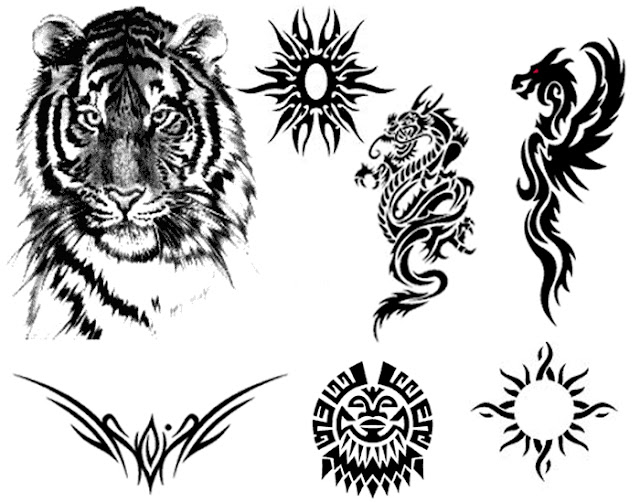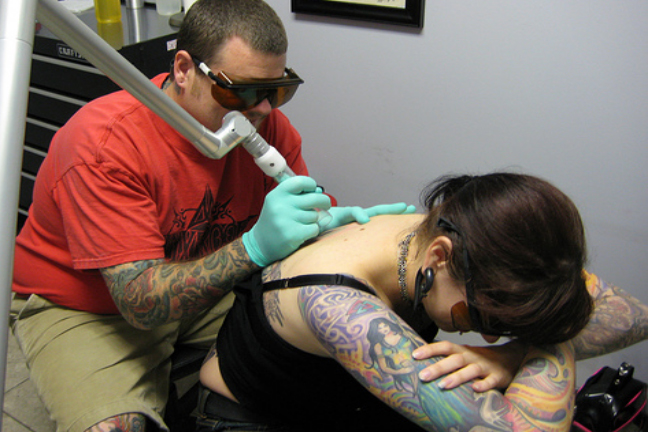10:45 PM |
Posted in
Hi everyone,... Welcome to www.tattooimg.blogspot.com
Category:
��
10:44 PM |
Posted in
A TATTOO is a marking made by inserting indelible ink into the layers of skin to change the pigment for decorative or other reasons. Tattoos on humans are a type of decorative body modification, while tattoos on animals are most commonly used for identification or branding.
Tattooing has been practiced worldwide. The Ainu, the indigenous people of Japan, traditionally wore facial tattoos. Today one can find Berbers of Tamazgha (North Africa), Maori of New Zealand, and Atayal of Taiwan with facial tattoos. Tattooing was widespread among Polynesian peoples and among certain tribal groups in the Taiwan, Philippines, Borneo, Mentawai Islands, Africa, North America, South America, Mesoamerica, Europe, Japan, Cambodia, New Zealand and Micronesia. Despite some taboos surrounding tattooing, the art continues to be popular in many parts of the world.
Category:
��
Category:
��
9:17 PM |
Posted in
Tattooing has been a Eurasian practice at least since around Neolithic times. Ötzi the Iceman, dating from the fourth to fifth millennium BC, was found in the Ötz valley in the Alps and had approximately 57 carbon tattoos consisting of simple dots and lines on his lower spine, behind his left knee, and on his right ankle. Other mummies bearing tattoos and dating from the end of the second millennium BC have been discovered, such as the Mummy of Amunet from Ancient Egypt and the mummies at Pazyryk on the Ukok Plateau.
Pre-Christian Germanic, Celtic and other central and northern European tribes were often heavily tattooed, according to surviving accounts. The Picts were famously tattooed (or scarified) with elaborate dark blue woad (or possibly copper for the blue tone) designs. Julius Caesar described these tattoos in Book V of his Gallic Wars (54 BC).
Tattooing in Japan is thought to go back to the Paleolithic era, some ten thousand years ago.[citation needed] Various other cultures have had their own tattoo traditions, ranging from rubbing cuts and other wounds with ashes, to hand-pricking the skin to insert dyes.
Tattooing in the Western world today has its origins in Polynesia, and in the discovery of tatau by eighteenth century explorers. The Polynesian practice became popular among European sailors, before spreading to Western societies generally.
Category:
��
Category:
��
9:10 PM |
Posted in
The basic machine was invented by Thomas Alva Edison and patented in the United States in 1876, Stencil-Pens. It was originally intended to be used as an engraving device, but in 1891, Samuel O'Reilly discovered that Edison's machine could be modified and used to introduce ink into the skin, and later patented a tube and needle system to provide an ink reservoir.
The technology used to make modern tattoo machines has come a long way, however. While O'Reilly's machine was based on the rotary technology of Edison's engraving device, modern tattoo machines use electromagnets. The first machine based on this technology was a single coil machine patented by Thomas Riley of London, just twenty days after O'Reilly filed the patent for his rotary machine. For his machine, Riley placed a modified door bell assembly in a brass box. The modern two coil configuration was patented by Alfred Charles South, also of London. Because it was so heavy, a spring was often attached to the top of the machine and the ceiling to take most of the weight off the operator's hand.
Most modern tattoo machines can control needle depth, speed, and force of application, which has allowed tattooing to become a very precise art form. Such advancements in precision have also produced a style of facial tattooing that has attained mainstream popularity in America called dermapigmentation, or "permanent cosmetics".
Category:
��
Category:
��
9:00 PM |
Posted in
Tattoo removal has been performed with various tools during the history of tattooing. While tattoos are considered permanent, it is sometimes possible to remove them with treatments, fully or partially. The expense and pain of removing tattoos will typically be greater than the expense and pain of applying them. Some jurisdictions will pay for the voluntary removal of gang tattoos.
Pre-laser tattoo removal methods include dermabrasion, salabrasion (scrubbing the skin with salt), cryosurgery, and excision which is sometimes still used along with skin grafts for larger tattoos. Tattoo removal by laser was performed with continuous-wave lasers initially, and later with Q-switched lasers, which became commercially available in the early 1990s. Today, "laser tattoo removal" usually refers to the non-invasive removal of tattoo pigments using Q-switched lasers. Typically, black and darker colored inks can be removed more completely.
Tattoo removal is most commonly performed using lasers that react with the ink in the tattoo, and break it down. The broken-down ink is then absorbed by the body, mimicking the natural fading that time or sun exposure would create. All Tattoo pigments have specific light absorption spectra. A tattoo laser must be capable of emitting adequate energy within the given absorption spectrum of the pigment in order to provide an effective treatment. Certain tattoo pigments, such as yellows, greens and fluorescent inks are more challenging to treat than the darker blacks and blues. These pigments are more challenging to treat because they have absorption spectra that fall outside or on the edge of the emission spectra available in the respective tattoo removal laser.
Laser tattoo removal often requires many repeated visits to remove even a small tattoo, and may result in permanent scarring. A brand of ink, InfinitInk, was developed to enable easier tattoo removal with a single laser treatment. The newer Q-switched lasers are said by the National Institute of Health to result in scarring only rarely, however, and are usually used only after a topical anesthetic has been applied. Areas with thin skin will be more likely to scar than thicker-skinned areas. There are several types of Q-switched lasers, and each is effective at removing a different range of the color spectrum. Lasers developed after 2006 provide multiple wavelengths and can successfully treat a much broader range of tattoo pigments than previous Q-switched lasers.
Category:
��
Category:
��
8:50 PM |
Posted in
Tattoo art tune that not only men but now women are also like a tattoo. Tattoo on the woman is slightly more revealing fashion. Therefore, a girl should think about whether a tattoo will look good with a bikini, or prom dress, or evening gown. Similarly, women tend to be slightly more careful about ensuring that the tattoo is concealable with professional or casual clothes.
Some tattoo ideas for girls and women who have a long history including: tribal, flowers, angel wings, fairy, star, butterfly, Celtic and Zodiac symbols, dolphin, rose, and heart. Although traditional, the idea is always unique tattoo by the means they use, and most tattoo artists are happy to create one-of-a-kind design.
Category:
��
Category:
��
.
Celebrities...
Followers
I Suppose...
LOVE is Something...
Beautyful,
That we can never...
Express in worlds,
Be emotional to...
LOVE
Then you CAN...
Understand...
what it is,
Because
LOVE is a gift to treasure
Forever...










